Scotland is an unknown for most of the English population. Yes, the population is very aware of the dominance of the SNP in its politics and we include it on all our national maps. But few venture onto its soil. For my solo trip to Oban, a port town in the Scottish Highlands, I took a train from Euston into the great unknown. It shot across the West Coast Mainline and was relentless in its pursuit of the Scottish border. Each stop along its route changed the accent of the packed train carriage progressively northern, albeit with a heavy and distinct Scottish presence. This streamlined train was a bit different to the trundling Metropolitan line I was used to back home, and its unsettling tilting thrust into sight the visible difference between the north and the bubble of Oxford and the home county that I inhabit. New perspectives were what I hoped this trip would give me, and I was getting them before I had even crossed the border. Perhaps this is a reflection on the suburban populace of the South and the unintentional but very present ignorance of the divides that persist in the country we live in. Even the £120 ticket price is evident of that.
After the four hours it took to reach Glasgow Central, I emerged into a city with stylistic buildings that felt similar to Oxford, yet far busier and a lot colder. Leaving the heatwave temperatures of 25C to be confronted with temperatures nearly at single figures was a bit of a shock – especially as I had just returned from the Canaries twelve hours before. And while the street did have a sense of familiarity, I was very aware I was in a different country. Upon entering Queen Street Station the Scottish voice on the tannoy announcement took me by surprise – why should it though? I guess this is a concrete example of my abject expectancy of Southern locale onto the rest of the UK. Even the rail operator – nationalised ScotRail – marked a distinct difference. My train from Glasgow to Oban was a near four-hour trundling affair with spectacular views of the Clyde and plentiful lochs and glaciated valleys as we weaved our way through the single line – which at some points was not for the faint hearted. As the train passed a glassy loch with impressive Georgian mansions, I remarked how it now made sense why the Royals spend so much time at their retreats here – It was lovely. I almost felt foolish for snapping away on my phone when I passed through the Lake District earlier – even under the gloomy light of early dusk it paled in comparison. Dusk was a good few hours later than down South which made the final stages of my journey bearable. After nearly 12 hours since I shut my front door and haphazardly marched to the station under the weight of my backpack – my two-week journey had begun.
I was staying in the centre of Oban at Backpackers Plus – a hostel in a converted church that was started by my great uncle. As I traversed the seafront from the station to the other side of the bay, I was nervous for what lay ahead. I had rarely been further north than Norfolk and only ever as far as Yorkshire. The hostel was homely, and a living area dotted with sofas and lamps occupied the spacious top floor with church eves creating a triangular hub – and glimpses of the yachts moored in the bay could be caught through the skylights. After unpacking into the dorm I was staying in, I strayed out along the promenade stopping to remark at the young bagpipers playing to a sizeable crowd. This was Scotland. The scenery was already spectacular with a broad expanse of bay surrounded by rolling hills. It was only in heading to Tesco where a sense of normalcy remained.
Oban is a small town of 9 thousand that more than doubles during the summer to over 20 thousand. Yet almost immediately I was surprised by how quiet my hostel, and the town in general seemed. Oban is a hub of the government subsidised Cal Mac ferries who service the Outer Hebrides, and inner Isles in this part of Western Scotland, it is therefore a transitory place, and one where dynamism is a key. It is a regional hub but as I settled into hostel life and helped with the running of it, it was clear that two big factors had made an impact on life.
For context this hostel provides free accommodation to volunteers in exchange for a few hours work each day – and before Brexit there were normally a dozen young volunteers who created a sense of community in and amongst the transitory. Since 2019 – the last pre-COVID and pre-Brexit year – volunteer numbers have dropped drastically, mainly due to EU citizens now needing a visa to volunteer here. This has been fully felt across this part of Scotland, which relied heavily on EU tourists and workers to sustain the industry here. There are many unfilled vacancies and the situation for the entire town is uncertain. Even I was one of only three volunteers at the hostel, and the scribbled messages left by previous visitors in the corridors over the past decade suggested the current hostel was only a shell of its past, and something had been lost. Regardless of the cause, it made my plans undergo a radical change. I was expecting to enter full social mode and go with the flow of the rest of the group. What I had to do now, and what I was unprepared for, was to explore this area solo. It was a fact, not a choice; and I seized it with determination.
The first day was spent exploring my immediate surroundings through the pouring rain which turned to hot sun in a matter of minutes and made for a long regret of my outfit choice for the remainder of the day. I walked to Garavan Sands, a large expanse of beach with stunning views, and then hiked over some cliffs along the coastal path to the settlement of Dunstable. It is the site to the Scottish Association for Marine Science and new European Marine Science Park – perhaps planned in a time when European collaboration seemed forthcoming. It was an odd sight, rows of new houses in an estate in the cradle of the peninsular between slopes of grassy expanse. Whether it is still being developed, or if European science has upped and left, the emptiness of the site was eerie and almost movie-like.
Thankfully it was a brief walk through the estate and science buildings to reach something completely different: Dunstaffnage Castle, one of Scotland’s oldest stone castles. While it was not impressive in its physical presence – castles are more plentiful than coffee shops in this part of the country – its prominence on a protruding jagged arrow of rock was. Walking through the ancient woodland that surrounded it, I came across the ruined Chapel – dating back to an equally impressive 13th Century. The small bays of this peninsular seemed almost from an era where Celtic clans battled for control of the land. It seems that history is everywhere in Scotland and history is living and breathing. Oban has its own castle, Dunolie, the historic home of Clan McDougal. And the human presence of 8,000 years is present in the caves that lie in the cliffs set back from the sea and from an era of higher sea levels and differing climate.
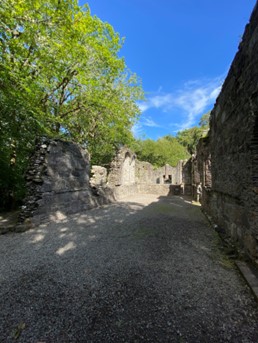
Following my first hike I decided to tackle the Isle of Kerrera – a sparsely populated and low-lying island that spreads into the bay of Oban. The ferry was a short five-minute trip, and I walked solo along the path to a tearoom and castle. I was struck by the friendliness of everyone – who all greeted me in return as I passed them. Down South and especially in London this is an unfortunate rarity. The Gylen Castle occupied a dominating position and I was able to enter and explore the ruins where I met a couple who I walked with. The impenetrable fortress withstood months of siege until it ran out of water – of all things – and the irony is not lost even today. As we vied to make it back for the last ferry a family of Germans joined our party, and we made headway. Despite my feet protesting for the following evening, I thoroughly enjoyed my exploration. The dreamy living the islands enjoy is being changed by the construction of a new road that runs around the island and allows e-bikes to be rented. Still, Kerera has embraced progress – an obelisk dominates its tip memorialising the man who brought steam ferries to the area and revolutionised Island life forever.

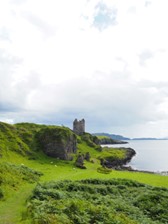
As I explored Oban more, I came across McCraig’s Tower, a building modelled on the colosseum and built as a memorial to the namesake family. Never finished, it became a public park and now offers spectacular views over the bay of Oban. The weather persisted to be dull, and I realised how depressing even just the weather was. Oban was built in a grand style that reflected its holiday resort heritage in the railway age. The buildings emit an air of grandeur and make the town seem important to the economy and people of the region. They’re typical for the country and similar styles can be found all over.
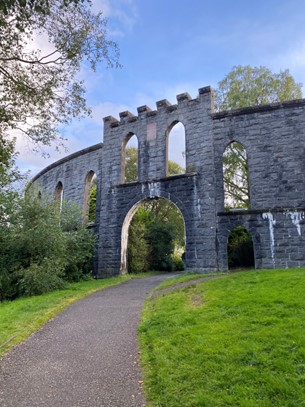
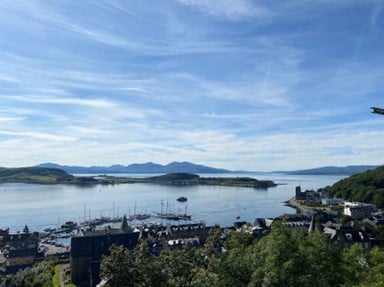
That night I went to a live music event at a local pub, which finally felt like I had entered the local life as opposed to the tourist one. For one the two young lads playing folk songs with an accordion was a marked difference to anything I had experienced in the UK, bar Burn’s Night which isn’t the best example to prove the point. Alcohol seemingly flowed freely the whole night and by midnight it was a very jovial affair with traditional dancing filling the room and singing echoing through the rafters. One tradition seemingly was to shout in a primitive roar in the faces of the musicians to show appreciation – it did shock me the first time. Everyone seemingly knew everyone and while I felt like an observer to the event, I didn’t mind it as it was an experience I felt privileged to be able to enjoy. The blatant alcohol abuse is emblematic of the epidemic sweeping the country, but the sheer joyous nature of the event was overwhelming. I laughed in disbelief as I walked home with my newly made friends huddled under an umbrella and shivering in two jumpers and a coat, while I knew that England was basking in a heatwave that was steadily turning into a drought. It seems that Scotland’s weather is becoming wetter and more intense and is a contrast to the warming elsewhere in the country.
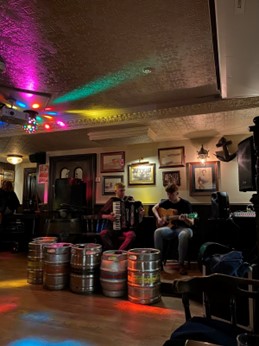
I was thankful when a week had passed and my uncle arrived with his car – and brought some good weather with him. Public transport is temperamental at best and unusable for anything less than a daytrip, with only a morning and evening service on most routes. We drove to the historic Glen Coe, a deep glaciated valley with towering peaks, and stunning scenery that regularly graced the Harry Potter franchise. On route we stopped at the Castle Stalker, a must-see for Monty Python fans – though I was seemingly too young to understand – but it was an impressive sight nonetheless. Transferred between clans after a drunken bet went wrong in the 17th Century, the history is as fascinating as the view. Completely obscured by fog in the late morning, but basked in brilliant sunshine by the afternoon, even in my short trip I saw it in a variety of scenes. Adjacent to the causeway leading to the castle is an abandoned rail station, scrapped under the sixties reforms and highlighting the reliance on the car that prevails today. The road to Glen Coe is dotted with road signs that have Gaelic translation under every road – perhaps this is the best example of the difference between Scotland and England – it certainly is the most obvious. European number plates nearly outnumber UK ones in this area, and the tourism industry is visible with various nationalities flocking to witness the stunning scenery.
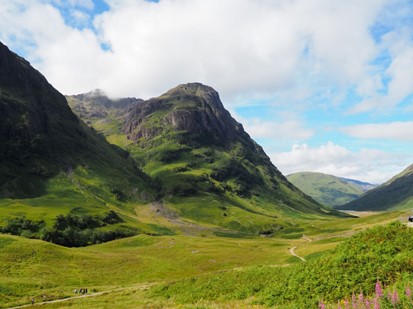
East Dale was a day trip my uncle took the other volunteers on. As we made our way along the funeral route Macbeth’s procession took to Iona history breathed deeply. We passed a pub named Tigh an Truish (House of Trousers) which lay across the Bridge Over the Atlantic (Clachan Bridge) on the Isle of Seil- a bit less impressive than the Golden Gate Bridge but still a notable attraction. The Inn is notable for the role it played during the British oppression of Scottish culture after the battle of Culloden in 1746, when wearing of the kilt was outlawed in Scotland. In defiance, the islanders wore the kilt when they were home but used the Inn to change into the hated trousers or trews when they went to the mainland. A stuffed scarecrow-like figure of a ‘redcoat’ hangs from the window. History is still very much remembered in this area even if England has long forgotten its actions here.

After a short drive across the Isle, East Dale emerged into view – a two minute boat ferry ride across to the only slipway. The island was a slate quarry and about a third of it is missing as it now consists of deep and in ordinarily rectangular quarry pools that have water so still it’s no surprise they are used for the World Skimming Championships. The community on the island lives without cars as it is so small – a barely hour walk let us circle the entire perimeter – and occupies the old quarry workers houses. It seems like a close-knit community, intertwined with some holiday lets, who weren’t very responsive to our welcoming smiles – but who could blame them for their frustration of eager tourists spying on their lives. This was the most beautiful island with panoramic views from its summit of various isles across the sea and on the most beautiful of days: it was breath-taking.
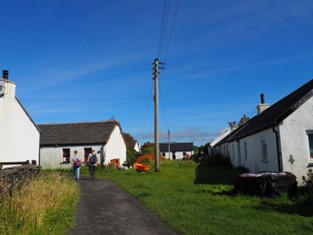
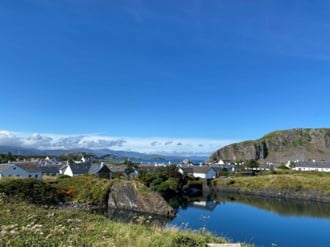
But Scotland never stops surprising, and the next day was a trip to the Isle of Mull. Despite the interrogation of the service in the Tory Press back in England after timetable mishaps the £7 return fare for an hour trip seemed pretty good to me. There are not many places you can buy breakfast in a ship canteen and watch the sea go by for that price. But that wasn’t the purpose of the trip. I was excited to visit somewhere that was on my bucket list. Tobermory. Or as it is better known: Balamory. While I was fast approaching my 20th Birthday, I was still excited to explore somewhere so present in my childhood. The coach ride captured more stunning scenery as we wove our way round to the other side of the island. The flags here were interesting – for every Scottish cross there was a Union Flag in the next garden to compete. We even passed a Confederate flag on one garage – much to my unsettled amazement – from which the two US tourists sitting next to us codified the shock.
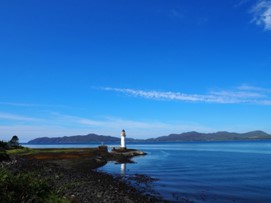
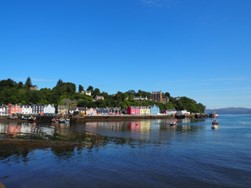
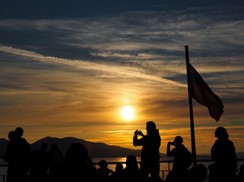
However, Tobermory itself was stunning and similar to Oban in building style. While the only shops were all for tourists, spending the day there was a breeze. One notable outlier was a Nepalese community shop in a converted church that had funded the rebuilding of a community centre after the devastating Earthquake. Wandering inside through the air infused with incense, arrays of authentic items could be bought, and it was a fitting way to see how the repurposing of Churches is readily prevalent – Oban has a preschool in one now. The dominance of the church is shrinking in these areas – though with over 10 in Oban alone it is clean to see the imbalance between supply and demand. Back in Tobermory, it was a short walk along the coast to one of Stevenson’s lighthouses – supposedly the one that inspired his son to write his infamous novel. As we sat and had afternoon tea at a hotel overlooking the bay, I felt fulfilled. The one thing I was realising was that when the weather is good, there is nowhere prettier to be in the World. It is quite literally stunning. This was evident on the ferry back, where the sunset bathed the entire scene in an orange glow and was an atmosphere I wanted to bottle up and keep forever. With my uncle having lived in Oban for ten years, I was able to experience and connect with many locals and realise what a kind, caring community they truly are. A pro-independence ‘YES’ marquee and stand was fixed along the promenade with big smiles and photo opportunities – even in craft stores ‘YES’ badges were placed proudly on the counter. For these people Europe seems more important than any previously oppressive neighbour and the EU flag overlaid on the campaign posters shows these people are very aware they have every right to request another vote: the EU changed everything for them.

Before long, my Uncle left and it was only a few days before the weather turned bad again, but for once it was a welcome reprieve as even temperatures of low twenties were unbearable in the humid climate – I took to lying down in the shade with an audio book. And then my final days in Oban passed in a haze of coastal runs, conversations with passing travellers and peaceful reflection. I could never tire of watching the goings-on of the harbour and the various watercraft milling about; and even on dreary days a sunset still managed to punch through and glow vividly. Despite the eventful train journey back home on the eve of industrial action I left feeling thoroughly fulfilled. The Scots are a proud people, proud in ways that the English cannot even imagine. They have a strong sense of place, of history and of the legacy of an oppressive British government led from London. It is easy to understand why nationalism here persists. Upon discovering my own Scottish heritage and Clan Mackenzie roots – albeit distant – I too feel a great deal of pride in this country. England could learn a lot from our northern neighbour and could resolve a lot if it listened instead of ignored.


